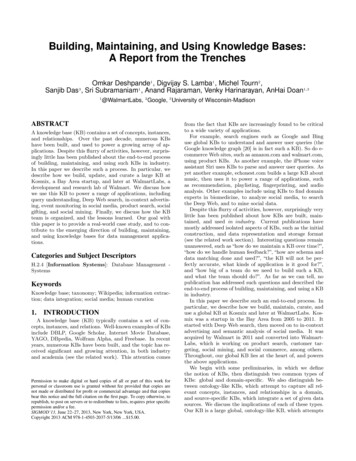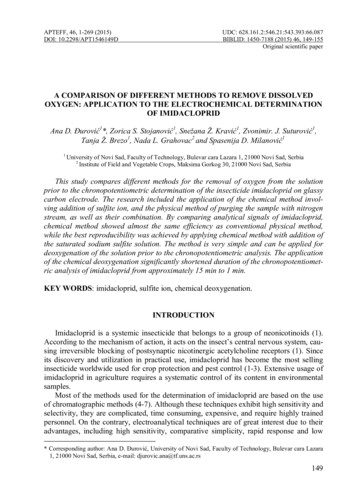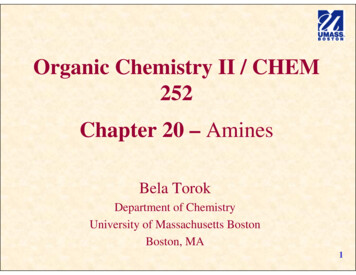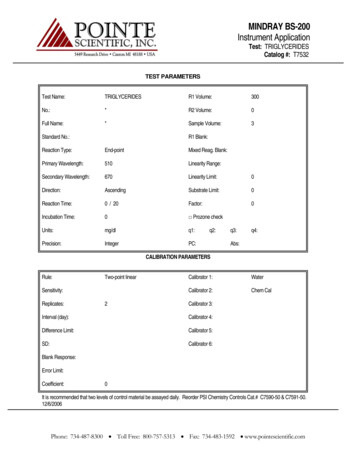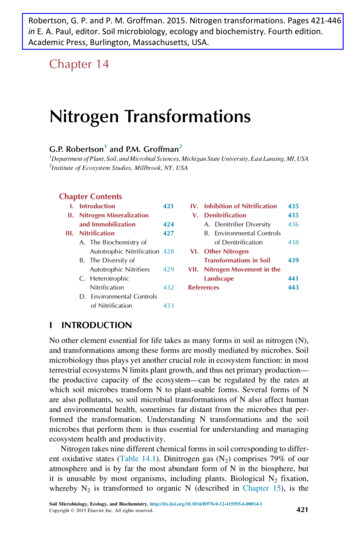
Transcription
Robertson, G. P. and P. M. Groffman. 2015. Nitrogen transformations. Pages 421-446in E. A. Paul, editor. Soil microbiology, ecology and biochemistry. Fourth edition.Academic Press, Burlington, Massachusetts, USA.Chapter 14Nitrogen TransformationsG.P. Robertson1 and P.M. Groffman212Department of Plant, Soil, and Microbial Sciences, Michigan State University, East Lansing, MI, USAInstitute of Ecosystem Studies, Millbrook, NY, USAChapter ContentsI. IntroductionII. Nitrogen Mineralizationand ImmobilizationIII. NitrificationA. The Biochemistry ofAutotrophic NitrificationB. The Diversity ofAutotrophic NitrifiersC. HeterotrophicNitrificationD. Environmental Controlsof NitrificationI421424427428429432IV. Inhibition of NitrificationV. DenitrificationA. Denitrifier DiversityB. Environmental Controlsof DenitrificationVI. Other NitrogenTransformations in SoilVII. Nitrogen Movement in ODUCTIONNo other element essential for life takes as many forms in soil as nitrogen (N),and transformations among these forms are mostly mediated by microbes. Soilmicrobiology thus plays yet another crucial role in ecosystem function: in mostterrestrial ecosystems N limits plant growth, and thus net primary production—the productive capacity of the ecosystem—can be regulated by the rates atwhich soil microbes transform N to plant-usable forms. Several forms of Nare also pollutants, so soil microbial transformations of N also affect humanand environmental health, sometimes far distant from the microbes that performed the transformation. Understanding N transformations and the soilmicrobes that perform them is thus essential for understanding and managingecosystem health and productivity.Nitrogen takes nine different chemical forms in soil corresponding to different oxidative states (Table 14.1). Dinitrogen gas (N2) comprises 79% of ouratmosphere and is by far the most abundant form of N in the biosphere, butit is unusable by most organisms, including plants. Biological N2 fixation,whereby N2 is transformed to organic N (described in Chapter 15), is theSoil Microbiology, Ecology, and Biochemistry. -1Copyright 2015 Elsevier Inc. All rights reserved.421
422Soil Microbiology, Ecology, and BiochemistryTABLE 14.1 Main Forms of Nitrogen in Soil and Their Oxidation StatesNameChemical FormulaOxidation StateNitrateNO-3 5Nitrogen dioxide (g)NO2 4NitriteNO-2 3Nitric oxide (g)NO 2Nitrous oxide (g)N2O 1Dinitrogen (g)N2Ammonia (g)NH3-3AmmoniumNH4 -3Organic NRNH3-30Gases (g) occur both free in the soil atmosphere as well as dissolved in soil water.dominant natural process by which N enters soil biological pools. All subsequent soil N transformations are covered in this chapter: (1) N mineralization,which is the conversion of organic-N to inorganic forms; (2) N immobilization,which is the uptake or assimilation of inorganic N forms by microbes andother soil organisms; (3) nitrification, which is the conversion of ammonium(NH4 ) to nitrite (NO-2 ) and then nitrate (NO-3 ); and (4) denitrification, which isthe conversion of nitrate to nitrous oxide (N2O) and to dinitrogen gas (N2).Other forms of N (Table 14.1) are involved in these conversions primarilyas intermediaries, and during conversion they can escape to the environment,where they can participate in chemical reactions or are transported elsewherefor further reactions.L ohnis (1913) first formulated the concept of the N cycle, which formalizesthe notion that N is converted from one form to another in an orderly andpredictable fashion (Fig. 14.1), and that at global scale, the same amount of dinitrogen gas that is fixed each year by N2 fixation must either be permanentlystored in deep ocean sediments or converted back to N2 gas via denitrificationto maintain atmospheric equilibrium.The fact that N2 fixation—both biological and industrial—now far outpaceshistorical rates of denitrification is the principal reason N has become a majorpollutant (Galloway et al., 2008). Making managed ecosystems more N conservative and removing N from wastewater streams, such as urban and industrialeffluents, are major environmental challenges that require a fundamental knowledge of soil microbial N transformations (Robertson and Vitousek, 2009).
Nitrogen Transformations Chapter14423FIG. 14.1 Schematic representation of the major elements of the terrestrial nitrogen cycle. Thoseprocesses mediated by soil microbes appear in red. Gases appear in brackets.Although the microbiology, physiology, and biochemistry of N cycleprocesses have been studied for over a century, much of our understandingof the N cycle has been derived from molecular and organismal scale studiesin the laboratory. Laboratory observations and experiments have characterized the nature and regulation of the processes discussed in this chapter,but their reductionist nature has caused us to sometimes overlook the surprising possibilities for microbial activity in nature, thus impairing our ability tounderstand the ecological significance of these processes. The occurrence ofdenitrification (an anaerobic process) in dry and even desert soils is one example: theory and years of laboratory work suggest that denitrification ought tooccur only in wetland and muck soils, but when new field-based methodsbecame available in the 1970s, it became clear that almost all soils supportactive denitrifiers.Key problems have also arisen from evaluating microbial N cycle processes in isolation from other biogeochemical processes (e.g., carbon (C)metabolism and plant nutrient uptake). This has resulted in an underestimationof the physiological flexibility of bacteria and archaea in nature (e.g., nitrifying denitrifiers, aerobic denitrifiers, anaerobic ammonium oxidation (anammox)). The disconnect between laboratory-derived knowledge and whatactually occurs in the field is a problem throughout soil microbial ecology,but is perhaps most acute in the area of N cycling, which has great practicalimportance at field, landscape, regional, and global scales. When we attemptto increase information from the microbial scale to address important questions relating to plant growth, water pollution, and atmospheric chemistryat ecosystem, landscape, and regional scales, this problem becomes especiallyobvious and significant.
424Soil Microbiology, Ecology, and BiochemistryII NITROGEN MINERALIZATION AND IMMOBILIZATIONA critical process in any nutrient cycle is the conversion of organic forms ofnutrients in dead biomass (detritus) into simpler, soluble forms that can be takenup again by plants and microbes. This conversion is carried out by microbes andother soil organisms that release, or mineralize, nutrients as a by-product of theirconsumption of detritus. Although microbes consume detritus primarily for asource of energy and C to support their growth, they also have a need for nutrients,especially N, to assemble proteins, nucleic acids, and other cellular components. Ifplant detritus is rich in N, microbial needs are easily met, and N release, or mineralization, proceeds. If plant detritus is low in N, microbes must scavenge inorganicN from their surroundings, leading to immobilization of N in their biomass.The key to understanding mineralization-immobilization is to “think like amicrobe,” that is, attempt to make a living by obtaining energy and C from detritus. Sometimes the detritus has all the N that the microbe needs, so as C is consumed, any extra N is released (mineralized) to the soil solution. Sometimes thedetritus does not have enough N to meet microbial needs, so as C is consumed,additional N must be immobilized from the soil solution. It has been shown thatmicrobes invest more energy in the synthesis of enzymes (e.g., amidases toacquire N and phosphatases to acquire P) to obtain nutrients that they need whendecomposing substrates of low quality. Microbial N uptake is also affected byorganism growth efficiency. Fungi have wider C:N ratios in their tissues thanbacteria and archaea and can grow more efficiently on low N substrates.Mineralization results in an increase, whereas immobilization results in adecrease in plant available forms of N in the soil. Traditionally, ammoniumhas been viewed as the immediate product of mineralization, and in the olderliterature, mineralization is often referred to as ammonification. More recently,recognition of the fact that plants can take up simple, soluble organic forms ofnutrients leads us to broaden our definition of mineralization products to includeany simple, soluble forms of N that can be taken up by plants (see Schimel andBennett, 2004). Plants from a variety of habitats have been shown to take upamino acids and other organic N forms; mycorrhizae can play a role in thisuptake by absorbing amino acids, amino sugars, peptides, proteins, and chitinthat are then used by their hosts as an N source.Mineralization and immobilization occur at the same time within relativelysmall volumes of soil. Whereas one group of microbes might be consuming aprotein-rich and therefore N-rich piece of organic matter (think seed or leguminous leaf tissue), another group, perhaps 100 μm away, might be consumingdetritus rich in C, but low in N (think leaf stalk or wood). The first group is mineralizing N, while the second is immobilizing it, perhaps even immobilizing thesame N that is being mineralized by the first. As a result of the simultaneousnature and small scale of these processes, it is important to make a distinctionbetween gross and net mineralization and immobilization. Gross N mineralization is the total amount of soluble N produced by microorganisms, and gross N
Nitrogen Transformations Chapter14425immobilization is the total amount of soluble N consumed. Net N mineralization is the balance between the two. When gross mineralization exceeds grossimmobilization, inorganic N in the soil increases (i.e., there is net mineralization). When gross immobilization exceeds gross mineralization, inorganic N inthe soil decreases (i.e., there is net immobilization).Soil fauna also play an important role in mineralization and immobilizationprocesses. They are responsible for much of the preliminary decomposition ofdetritus, they feed on and can regulate populations of bacteria and fungi, andthey can create or modify habitats for a wide array of organisms. For example,earthworms create burrows, isopods shred leaf litter, and termites maceratewood. All heterotrophic soil organisms consume organic materials for energyand C and, at the same time, immobilize and mineralize N.The widely distributed nature of mineralization and immobilization processes means that the environmental regulation of these processes is relativelystraightforward. Rates of activity increase with temperature and are optimal atintermediate soil water contents, similar to respiration, as seen in Fig. 14.2,although it is important to recognize that significant activity often occurs atextremes of both temperature and moisture. In most soils, the quantity and quality of detrital inputs are the main factors that control the rates and patterns ofmineralization and immobilization. When moisture and temperature are favorable, large inputs of organic matter lead to high rates of microbial activity andthe potential for high rates of mineralization and immobilization. However, insoils that are waterlogged or very cold (think wetlands or Arctic tundra),FIG. 14.2 The relationship between water-filled pore space (a measure of soil moisture availability) and relative amount of microbial activities. Redrawn from Linn and Doran (1984).
426Soil Microbiology, Ecology, and Biochemistrymoisture and temperature can limit microbial activity, and soil organic matterand the organic N it contains will accumulate due to low rates of mineralization.Water-filled pore space (WFPS) is a useful measure to examine moisture’sinfluence on soil biological activity because it includes information about theimpact of soil water on aeration in addition to information on water availabilityper se. The calculation of %WFPS is%WFPS ¼soil water content bulk density 100:1-ðbulk density 2:65Þ(14.1)Soil water content is determined gravimetrically (g H2O/g dry soil), bulk density(g cm-3) is the oven dry weight of a given soil volume, and the value 2.65 is thedensity (g cm-3) of sand grains and other soil mineral particles.What controls the balance between N mineralization and immobilization?The answer is primarily organic matter quality—the availability of C in thematerial relative to its available N. Consider the effects of adding variousorganic materials with different C:N ratios to soil (Table 14.2). When one addsto soil manure with a relatively low C:N ratio (ca. 20:1), the microbes have notrouble obtaining N, and as a result, mineralization dominates over immobilization, and plant-available N increases in soil. This is why manure is frequentlyused as a fertilizer. On the other hand, were one to add sawdust to soil, a materialwith a high C:N ratio (625:1), the microbes would be keen to obtain the energyTABLE 14.2 C:N Ratios in Various Organic MaterialsOrganic MaterialC:N RatioSoil microorganisms8:1Soil organic matter10:1Sewage sludge9:1Alfalfa residues16:1Farmyard manure20:1Corn stover60:1Grain straw80:1Oak litter200:1Pine litter300:1Crude oil400:1Conifer wood625:1From Tisdale et al. (1993) and Hyv onen et al. (1996).
Nitrogen Transformations Chapter14427and C in the sawdust, but could not degrade this material without additional Nbecause the sawdust does not have sufficient N to allow the microbes to buildproteins. Thus, the microbes must immobilize N from their environment, resulting in a decrease in plant-available N in the soil. If there is no N to immobilize,microbial growth is slowed.The balance between mineralization and immobilization is also affected byorganism growth efficiency. For example, fungi have wider C:N ratios in theirtissues than bacteria and therefore, have a lower need for N and will thus mineralize N more readily. As a general rule of thumb, materials with a C:N ratio 25:1 stimulate immobilization, whereas those with a C:N ratio 25:1 stimulatemineralization (Table 14.2). Highly decomposed substances such as soilorganic matter, humus, and compost, in which labile C and N have beendepleted, are the exception to this rule. Even though these substances may havea low C:N ratio, the undecomposed C is in complex forms inherently resistant todecomposition, so mineralization also proceeds slowly.There are a wide variety of methods for measuring mineralization andimmobilization (Hart et al., 1994; Robertson et al., 1999). Measurement ofnet mineralization and immobilization rates is much easier and more commonthan is the measurement of gross rates. Measurement of net rates usuallyinvolves measuring changes in inorganic N levels in some type of whole soilincubation. In most cases, these incubations are in containers, with no plantuptake or leaching losses, and changes in inorganic N levels are measured byperiodic extractions of the soil. Incubation methods vary widely, from short(10-day) incubations of intact soil cores buried in the field to long ( 52-week)incubations of sieved soils in the laboratory. Gross rates are measured using isotope dilution methods whereby small amounts of 15N-labeled ammonium areadded to the soil, and the subsequent dilution of the 15N with natural 14N frommineralized organic matter is used as a basis for calculating the gross productionand consumption of ammonium.III NITRIFICATIONNitrification is the microbial oxidation of ammonia to less reduced forms, principally NO-2 and NO-3 . Autotrophic bacteria, first isolated in the late 1800s, gainas much as 440 kJ of energy per mole of NH3 oxidized when NO-3 is the endproduct. We know now that archaea and heterotrophic microbes can also nitrify,although autotrophic nitrification appears to be the dominant process inmost soils.The importance of nitrifiers to ecosystem function is substantial: althoughsome nitrate enters ecosystems in acid rain or as fertilizer, in most ecosystems,nitrate is formed in situ via nitrification. Because nitrate is an anion, it is moremobile than ammonium, the ionized source of NH3 in soil water:NH4 ðaqÞ NH3 ðaqÞ H ðaqÞ:(14.2)
428Soil Microbiology, Ecology, and BiochemistryAs a positively charged ion, ammonium can be held on cation-exchange sitesassociated with soil organic matter, clay surfaces, and variable-charge minerals.Nitrate, on the other hand, is mostly free in the soil solution and can be easilytransported out of the rooting zone by water when precipitation exceedsevapotranspiration.Nitrification in many soils is a major source of soil acidity, which can havemultiple effects on ecosystem health, including the mobilization of toxic metalsand the hydrologic loss of base cations as hydrogen ions displace other cationsfrom exchange sites. In soils dominated by variable-charge minerals, whichinclude most highly weathered tropical soils, soil acidity largely controlscation-exchange capacity (CEC), and nitrifier-generated acidity can driveCEC to very low levels. Further, some plants and microbes appear better ableto take up ammonium than nitrate, and vice versa, implying a potential effect ofnitrifiers on plant and microbial community composition. Finally, nitrifiersthemselves can also be direct and important sources of the atmospheric gasesNOx and N2O through nitrifier denitrification when O2 is low (Zhu et al.,2013) or via by-product formation.A The Biochemistry of Autotrophic NitrificationAutotrophic nitrification is a two-step process, carried out by separate groups ofbacteria and archaea—the ammonia and nitrite oxidizers, respectively. Autotrophic nitrifiers derive their C from CO2 or carbonates, rather than from organicmatter, and are obligate aerobes. The NH3 oxidation is characterized as:NH3 11 2O2 ! NO-2 H H2 O:(14.3)The first step in this oxidation is mediated by the membrane-bound enzymeammonia mono-oxygenase, which can also oxidize a wide variety of organic,nonpolar low-molecular-weight compounds, including phenol, methanol, methane, and halogenated aliphatic compounds, such as trichloroethylene:ammonia mono oxygenaseNH3 2H O2 2e- ! NH2 OH H2 O:(14.4)The reaction is irreversibly inhibited by small quantities of acetylene, whichinhibits ammonia mono-oxygenase. This provides a means for experimentallydifferentiating autotrophic from heterotrophic nitrification in soil. Hydroxylamine is further oxidized to nitrite by the reactionNH2 OH oxidoreductaseNH2 OH H2 O ! NO-2 4e- 5H :(14.5)Two of the four electrons released in this reaction are used in the prior NH3 oxidation step; the remaining two are used in electron transport, generating energyfor cell growth and metabolism:terminal oxidase2H 1 2O2 2e- ! H2 O:(14.6)
Nitrogen Transformations Chapter14429FIG. 14.3 Autotrophic nitrification pathways including pathways for gas loss. Broken lines indicate unconfirmed pathways. From Firestone and Davidson (1989).Intermediary compounds formed during the oxidation of hydroxylamine tonitrite can result in the formation of NO (Fig. 14.3), which can escape to theatmosphere and influence the photochemical production of ozone (O3) andthe atmospheric abundance of hydroxyl (OH) radicals, primary oxidants for anumber of tropospheric trace gases, including methane. Ammonia oxidizersare also able to produce NO via NO-2 reduction, which results in the productionof N2O, an important greenhouse gas that can also escape to the atmosphere.Nitrite reduction occurs when ammonia oxidizers use NO-2 as an electronacceptor when O2 is limiting—effectively becoming denitrifying nitrifiers!In most soils, the nitrite produced by ammonia oxidizers does not accumulate, but is quickly oxidized to nitrate by the nitrite-oxidizing bacteria when theyperform nitrite oxidation:nitrite oxidoreductaseNO-2 H2 O ! NO-3 2H 2e- :(14.7)These reactions are membrane-associated, and because nitrite oxidoreductase isa reversible enzyme, the reaction can be reversed to result in nitrate reduction tonitrite. Up to 80% of the energy produced during nitrification is used to fix C;growth efficiencies of the nitrifiers are correspondingly low.BThe Diversity of Autotrophic NitrifiersOur taxonomic understanding of nitrifiers has been fundamentally transformed in the last few years by new molecular techniques that have revealedconsiderable taxonomic diversity, where before we thought there was little.The development and use of 16S rRNA gene primers and subsequent metagenomic techniques targeting genes for ammonia monooxygenase (amoA)have demonstrated both a greater diversity among bacterial nitrifiers as wellas the presence of nitrifiers in a completely different kingdom, the Archaea.Remarkably, as first noted by Leininger et al. (2006), growing evidence suggests that archaeal nitrifiers may be as, or more, abundant than bacterial nitrifiers in many soils! Although, to date, we know little about the ecological
430Soil Microbiology, Ecology, and Biochemistrysignificance of this discovery, inference from nitrifiers successfully isolatedfrom the marine environment suggests that archaeal soil nitrifiers may dominate in oligotrophic microenvironments where NH3 concentrations are verylow. The best-studied marine isolate has a vanishingly low substrate affinityfor NH4 —over 200 times lower than that of the lowest bacterial isolate(Martens-Habbena et al., 2009). A soil isolate has only recently been cultured(Lehtovirta-Morley et al., 2011), and if its physiology is similar to the abovenitrifiers, may be far more competitive for NH4 in soil than is currentlyassumed. Such a substrate affinity may also give them access to NH3 evenin acid soils where high H concentrations favor NH4 over NH3 (aq; Heet al., 2012).Prior to 2000, the bacterial nitrifiers were viewed as the single familyNitrobacteraceae, defined by their characteristic ability to oxidize ammoniaor nitrite. Early work beginning with Winogradsky (1892) classified theammonia-oxidizing genera of Nitrobacteraceae on the basis of cell shape andthe arrangement of intracytoplasmic membranes. This yielded five genera:Nitrosomonas, Nitrosospira, Nitrosococcus, Nitrosolobus, and Nitrosovibrio.Recent work with isolates, based principally on 16S rRNA oligonucleotideand gene sequence analysis, places terrestrial ammonia-oxidizing bacteria inthe beta subclass of the Proteobacteria (Fig. 14.4); Nitrosolobus and Nitrosovibrio are no longer considered distinct from Nitrosospira, and Nitrosococcus isFIG. 14.4 A 16S ribosomal RNA guide tree for bacterial nitrifiers in the Betaproteobacteria basedon isolates. The scale is substitutions per site. Redrawn from Norton (2011).
Nitrogen Transformations Chapter14431FIG. 14.5 16S rRNA-based phylogenetic tree of the betaproteobacterial ammonia oxidizers. Thetree includes oxidizers of different genospecies (DNA-DNA similarity 60%) with available 16SrRNA gene sequences longer than 1000 nucleotides. Strains with DNA-DNA similarity 60% arein parentheses after the respective species name. Described species are depicted in bold. Scale barrepresents 10% estimated sequence divergence. From Koops et al. (2006).being reclassified to Nitrosomonas (Norton, 2011). Today, we have almostcomplete 16S rRNA gene sequences with 1000 nucleotides for the 14described species of Betaproteobacteria ammonia oxidizers, which have a genesequence similarity of 89% (Fig. 14.5; Koops et al., 2006).
432Soil Microbiology, Ecology, and BiochemistryIn arable soils, the Nitrosomonas communis lineage is numerically dominantamong culturable strains. Unfertilized soils usually also contain strains of theNitrosomonas oligotropha lineage and strains of Nitrosospira and Nitrosovibrio(Koops and Pommerening-R oser, 2001). The latter two tend to be dominant inacid soils, which contain few if any Nitrosomonas.Molecular techniques, such as 16S rRNA sequencing and the retrieval ofamoA clones, have been used to examine the diversity of ammonia oxidizersin vivo, which avoid the need for pure-culture cultivation and its bias towardthose species that are cultivatable outside their native habitat. Although molecular techniques can themselves be biased because of their dependence on theextraction of nucleic acid from soil, PCR amplification, primer bias, and cloning methods, they nevertheless suggest that most soils are dominated by Nitrosospira and archaeal species—and not by Nitrosomonas (Prosser, 2011). Thearchaeal species are currently found in the new archaeal phylum Thaumarchaeota. Their ubiquity, numerical dominance in soils thus far examined, andunique physiology suggest surprises in store.Worth noting in general is that neither classical nor molecular techniquesnormally provide quantitative information about the abundance and activityof different species in situ. Quantitative PCR and newer techniques based onmembrane or in situ hybridization in concert with rRNA-targeted probes(e.g., fluorescence in situ hybridization or FISH, as used in aquatic and wastewater treatment studies; Juretschko et al., 1998) can directly relate communitystructure with activity and spatial distribution of targeted organisms. Prosserand Embley (2002) have shown how these techniques can be used to discovernitrifier community change in response to changes in ecosystem managementand land use. Stable isotope probing can also demonstrate the activity andgrowth of particular groups; Zhang et al. (2010) used 13CO2 stable isotope probing to show the incorporation of 13C-enriched CO2 into the amoA and hcd genesof Thaumarchaea in soil microcosms.Nitrite-oxidizing bacteria appear in a broader array of phylogenetic groupingsthan do the ammonia oxidizers, but only the genus Nitrobacter and the candidategenus Nitrotoga have been cultured from soil (Daims et al., 2011). The 16S rRNAanalysis shows the presence of Nitrospira in most soils, which appear to be morediverse than Nitrobacter (Freitag et al., 2005). Members of Nitrobacter form anexclusive and highly related cluster in the Alphaproteobacteria. Though widelydistributed in nature, pairwise evolutionary distance estimates are less than1%, indicating little genetic diversity within the group, a finding supported by16S rRNA sequence comparisons (Orso et al., 1994). The other nitrite-oxidizinggenera are in the delta (Nitrospina and Nitrospira), gamma (Nitrosococcus), andbeta (Candidatus Nitrotoga) subclasses of the Proteobacteria.C Heterotrophic NitrificationA wide variety of heterotrophic bacteria and fungi have the capacity to oxidizeNH4 . So-called heterotrophic nitrification is not linked to cellular growth, as it
Nitrogen Transformations Chapter14433is for autotrophic nitrification. There is evidence for two pathways for heterotrophic ammonia oxidation. The first pathway is similar to that of autotrophicoxidation, in that the nitrifying bacteria have similar ammonia- andhydroxylamine-oxidizing enzymes. These enzymes can oxidize a number ofdifferent substrates, and it may be that ammonia oxidation is only secondaryto these enzymes’ main purpose of oxidizing propene, benzene, cyclohexane,phenol, methanol, or any of a number of other nonpolar organic compounds.The second heterotrophic pathway is organic and appears limited to fungi. Itinvolves the oxidation of amines or amides to a substituted hydroxylamine followed by oxidation to a nitroso and then a nitro compound with the followingoxidation states:RNH2 ! RNHOH ! RNO ! RNO3 ! NO-3:-3-1 1 3 5(14.8)These reactions are not coupled to ATP synthesis and thus produce no energy.Alternately, N compounds may react with hydroxyl radicals produced in thepresence of hydrogen peroxide and superoxide, which may happen when fungirelease oxidases and peroxidases during cell lysis and lignin degradation.Heterotrophic bacteria such as Arthrobacter globiformis, Aerobacter aerogenes, Thiosphaera pantotropha, Streptomyces grisens, and various Pseudomonas spp. have been found to nitrify. The fungi Aspergillus flavus was firstisolated as a nitrifier in 1954 and is the most widely studied of the nitrifyingheterotrophs. Interest in heterotrophic nitrification increased substantially inthe late 1980s when it became clear that accelerated inputs of atmosphericammonium to acid forest soils were being nitrified to nitrate with alarmingeffects on soil acidity, forest health, and downstream drinking water quality.Until recently, it was assumed that most of this nitrification was heterotrophic;we know now that most nitrification in acid soils is autotrophic (De Boer andKowalchuk, 2001), and as noted earlier, may be chiefly performed by archaealnitrifiers able to scavenge NH3 in low pH soils (He et al., 2012). Heterotrophicnitrification thus appears important in some soils and microenvironments, perhaps where autotrophic nitrifiers are chemically inhibited (see following section), but are thought now to rarely dominate the soil nitrifier community.D Environmental Controls of NitrificationThe single most important factor regulating nitrification in the majority of soilsis ammonium supply (Fig. 14.6). Where decomposition and thus N mineralization is low, or where NH4 uptake and thus N immobilization by heterotrophs orplants is high, nitrification rates will be low. Conversely, any ecosystem disturbance that increases soil NH4 availability will usually accelerate nitrificationunless some other factor is limiting. Examples are tillage, fire, clear cutting,waste disposal, fertilization, and atmospheric N deposition—all of which havewell-documented effects on nitrate production in soils, mostly due to theireffects on soil NH4 pools.
434Soil Microbiology, Ecology, and BiochemistryFIG. 14.6 Environmental controls on nitrification at different scales. From Robertson (1
424 Soil Microbiology, Ecology, and Biochemistry. immobilization is the total amount of soluble N consumed. Net N mineraliza-tion is the balance between the two. When gross mineralization exceeds gross immobilization, inorganic N in the soil increases (i.e., there is net mineraliza-



